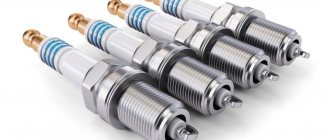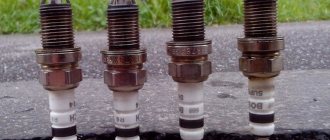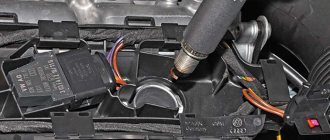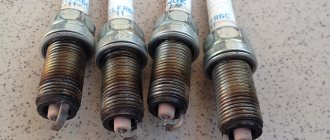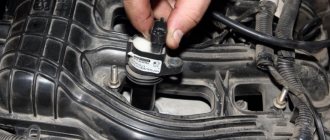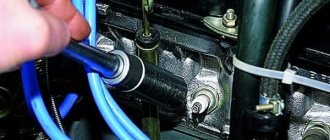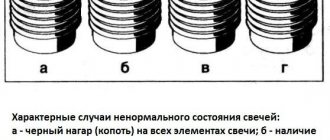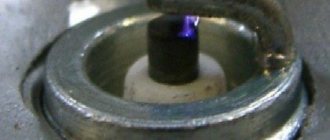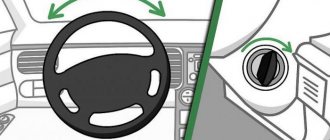To tighten the spark plugs, special spark plug wrenches are used; they are measured by the diameter of the threads on them.
Spark plug sizes:
— 16 (mm) and 14 (mm): used for modern internal combustion engines; — 19 (mm): for motorcycle engines; — 20.8 (mm): old European standard; — 22 (mm): for old-style spark plugs for ZIL and ZIS cars; — 24 (mm): for M8 brand spark plugs.
21st key:
The 21st key is the standard 20.8 (mm) spark plug key, which is used on engines with two valves per cylinder. This key is considered the main one for almost all Soviet passenger cars.
All modern spark plugs, regardless of which company they are manufactured by or what features they have (for example, spark plugs with platinum elements), have a completely identical device.
They include components:
- contact nut for high voltage wires;
- insulator (heat-resistant ceramic);
- a faceted metal insert on the insulator, used for unscrewing the spark plug with a key;
- sealing ring;
- lateral contact;
- central contact.
There should always be a working gap between the last two elements (for injectors - about 1 mm) - in this gap a high-voltage spark will jump, igniting the working mixture in the cylinder (a separate spark plug is installed for each engine cylinder).
As for the period after which it is necessary to replace spark plugs on a VAZ 2114, it is: about 10 thousand km for simple budget-level spark plugs, about 15-25 thousand km for simple spark plugs from “branded” manufacturers, about 70- 100 thousand km for platinum/iridium spark plugs.
Selecting a spark plug key
I decided to buy myself a spark plug wrench, it will always come in handy in a car =) Although the spark plug wrench is a standard 16mm, there are several implementations of these keys: 1) A key on a hinge The most
wretched key, at best you won’t be able to unscrew anything with it... It often breaks in the hinge area .
2) Like the first one, only without a hinge
It’s not very convenient to use, you can’t feel the tightening force, but as a last resort, if you lengthen the handle, you can change the spark plugs.
3) Spark plug wrench with crank
It is a little more convenient than the option above, due to the fact that using a knob you can make a larger lever (i.e., you do not need to increase the length of the handle).
4) Spark plug head + extension + ratchet wrench or torque wrench
The most convenient option, and using a torque wrench, is also the most correct =) But there are also subtleties here. Spark plug heads usually have a 3/8 or 1/2 inch connecting square, i.e. It is advisable to also choose the remaining elements (key and extension cord) with the same square, otherwise you will have to resort to adapters.
To fix the candle in the head in order to remove it from the well, either a rubber band or a magnet is most often used. I can’t say which is more convenient and reliable, because... I used only a head with a rubber insert, it holds the spark plug well. Although if the rubber wears out, problems may arise. Well, if you use a torque wrench, then the tightening torque for our engine is 20 - 25 Nm, I chose 22 Nm, as some spark plug manufacturers write.
Source
The best spark plug wrenches "head" type
| # | Model | Spark plug type | Average price, rubles | Photo |
| 1 | Delo Techniki 620656 | Magnetic | 290 | |
| 2 | Berger BG2021 | Polyurethane ring | 160 | |
| 3 | OMBRA 112116A | Rubber ring | 175 |
Essentially, this is a regular socket for any 1/2 or 3/8 ratchet wrench, but with a longer body than a regular 14, 16 or 21 mm socket.
In first place is a domestic product under the Delo Tekhniki brand with a magnetic fastener at a very reasonable price.
In second place is the Berger VG2021 spark plug head with a polyurethane retainer. A reliable tool, but there is a possibility of running into a fake.
In third place is the OMBRA head with a rubber retainer. This particular model has been tested by time - the elastic began to fly off only after prolonged use. This ailment was easily corrected with the help of ordinary sealant. This model also came in 3rd place due to the fact that it is thin-walled and polished.
Progress
Before carrying out any work, you need to make sure that the engine has already cooled down. When replacing spark plugs, you should first remove the wire cap from the spark plug insulator. To make removal easy, it is recommended to swing the cap to the sides, pull it in the upper direction, and then finally remove it and put it to the side.
Next, the spark plug key prepared from the kit must be put on the spark plug. Using slight pressure while moving the part in a counterclockwise direction, it is necessary to unscrew it from the block head. With this approach, the part can be easily unscrewed. After this, you should carefully examine the part itself. Under normal operating conditions there will be no soot or oil marks on it. When replacing, it is recommended to select ignition elements whose characteristics are indicated in the technical manual for the car, for example, ngk.
Standards for sizing parts
After removing the old element, you must carefully screw the new part into the spark plug hole using clockwise turns. Using a spark plug wrench with the required parameters from the kit, screw the part into the block head with little force. It is important to observe the correct tightening torque. Fluctuations in tightening torque can lead to malfunctions, but correctly set torque will avoid problems. Next, you need to put the wire cap on the spark plug insulator.
When installing a new part, for example, ngk, it is necessary to correctly align its gap. This will allow you to make a special probe. The feeler gauge allows you to correctly determine the size of the gap. This is important because increased or decreased clearance will impair the functionality of the part. The probe has a set of hooks in its design. The hooks from the feeler gauge set allow you to correctly measure the gap. The size of the gap between the electrodes is strictly fixed, and the probe helps to determine inconsistencies. After measuring using a feeler gauge, you can adjust the gap as necessary.
How to use a spark plug wrench?
The need to replace spark plugs can arise at any time and anywhere, and neither expensive nor cheap cars are immune from this. It should be remembered that spark plugs can only be changed when the engine is cool. Otherwise, you can break the thread that is in the spark plug hole. Replacement using a key occurs in the following order:
- We select a car spark plug wrench that matches the size of the spark plugs.
- We put the head of the key on the spark plug, making sure that it fits tightly (this is especially true for devices with a rubber retainer).
- Holding the key handle, we make 2-3 turns counterclockwise with smooth, leisurely movements and without excessive effort. If a slight grinding noise is heard, it means the spark plug is moving.
- Manually unscrew the spark plug all the way.
- When installing spark plugs into the cylinder block, we carry out all the steps in the reverse order.
Replacement problems
It is worth noting that some problems may arise during replacement. For example, an old part may be damaged. In this case, you need to figure out how to unscrew the broken spark plug. This can be done using drilling. This is a rather labor-intensive procedure, and it should be entrusted to the specialists of a car service center. They know exactly how to remove a broken spark plug and can do it correctly.
It is also important to install a repaired spark plug when the thread was previously torn off. If the candle has retained its functionality, but the thread is torn off, then a screwdriver or a foot for the candle will help correct the situation. The screwdriver allows you to install a working part into the socket. It is important that the screwdriver has a diameter suitable for the specific part.
Appearance of the screwdriver
During repair work, the screwdriver is installed in the head. The screwdriver assumes there is space for installing the spark plug. Once the screw is installed correctly, you can screw the spark plug into it. At the same time, the screwdriver allows for the correct installation of the part in a new place for it. Thus, the screwdriver will help correct the situation in case of a broken thread.
What does the color of soot indicate?
When inspecting the electrode and thermal cone of the insulator of the old element, you should pay attention to the color of the carbon deposits. If black dry carbon is present, it can be concluded that the engine is being used at low speeds or idling. If the carbon is black in color and has an oily structure, we can talk about wear on the cylinders and piston rings, as well as an excessive oil level in the crankcase. If a part, for example an ngk, is operating under normal conditions, its insulator will be light gray or light brown. There is no soot in this case.
Replacing glow plugs
The procedure for replacing glow parts does not differ significantly from the procedure for replacing spark plugs. Glow elements are used in engines that use diesel for operation. In this case, incandescence allows you to achieve the required temperature for self-ignition of the diesel engine. The quality of the diesel engine greatly influences the performance characteristics of the incandescent elements.
It is important that you can unscrew the old parts using the glow plug puller from the kit. It can have different parameters depending on the dimensional characteristics of the candle itself and is often included in a set of similar tools. The glow plug puller allows you to quickly remove a worn-out spark plug and then replace it with a new one.
Filament elements
After installing the glow element, for example, ngk, and checking the correctness of this procedure, you can start the engine. It is important to fill with high-quality diesel. A good diesel engine is the key to long-term operation of incandescent elements. Therefore, the quality of diesel must be carefully monitored. More details on the procedure for replacing incandescent elements can be found in the video:
What is a spark plug wrench?
Experienced drivers can easily cope with minor repairs, for example, replacing car spark plugs, but beginners do not always know how to do this. To quickly and efficiently remove and then install spark plugs, use a device such as a spark plug wrench - this is the most convenient and reliable tool. Its special design is specifically designed to work in confined spaces under the hood of a car. Such a tool is made from vanadium or carbon steel, subjected to hardening and chrome plating.
What does a spark plug key look like?
This device is a long metal key. On one side, the tool for replacing spark plugs has a handle, and on the other, a multifaceted tubular cylinder, inside of which there is a spark plug retainer. This design ensures unhindered rotation of the part. There are three types of clamps:
Source
Preparation
Before you start unscrewing the igniters, you need to prepare. First, you need to wait until the engine has completely cooled down. When heated, the aluminum cylinder head expands and clamps the spark plugs into the threads, making it impossible to unscrew them. In addition, a cold unit will protect you from burns.
The simple fact is that almost every time you try to remove these spark plugs, at least one of them breaks into the cylinder head, or worse, the threads from the cylinder head are damaged or come out of the spark plug. The picture below shows a spark plug that has been punched inside the cylinder head.
Problem #1: The spark plug is stuck in the cylinder head or has broken. Also the cylinder head is aluminum, the spark plug has steel and other components, and 2 dissimilar metals will lead to corrosion. Recommended steps to try to remove the plugs without breaking them.
For the twisting procedure, you need to prepare the following tools and materials:
- torque wrench;
- special hexagon;
- compressor;
- WD-40 oil.
After the engine has cooled, you need to disconnect all contacts. Using special means and a clean rag, you must thoroughly clean the location of the heating elements from dirt so that nothing falls into the spark plug well.
Using a compressor with a thin tube or other device that pumps air, you need to blow out the well itself. This must be done very carefully, as there is usually a lot of debris and dirt in the nest. After blowing, you need to fill the socket with WD-40 oil. It will lubricate the thread and make it easier to unscrew. You can start work 10-15 minutes after the oil has been added.
Of course, I like doing this type of work and don't mind it at all. Use high quality, high quality tools that will allow you to get a nice firm and square position on each spark plug. The passenger side of the engine is where most of the damage occurs, so pay special attention to them.
The spark plugs are loose or actually removed directly from the cylinder head and tend to pull or pull the threads off of them. Believe it or not, this actually happens, and it happens very often. Typical symptoms include a very loud exhaust noise coming from the engine bay area, an immediate misfire, and most likely a check engine light will soon follow. Oh, and another symptom is that there is probably a spark plug or spark plug pieces located somewhere in the engine bay, and your ignition coil may or may not be attached to the top of that spark plug.
What kind of key is needed for spark plugs
To tighten the spark plugs, special spark plug wrenches are used; they are measured by the diameter of the threads on them.
Spark plug sizes:
– 16 (mm) and 14 (mm): used for modern internal combustion engines; – 19 (mm): for motorcycle engines; – 20.8 (mm): old European standard; – 22 (mm): for old-style spark plugs for ZIL and ZIS cars; – 24 (mm): for M8 brand spark plugs.
21st key:
The 21st key is the standard 20.8 (mm) spark plug key, which is used on engines with two valves per cylinder. This key is considered the main one for almost all Soviet passenger cars.
All modern spark plugs, regardless of which company they are manufactured by or what features they have (for example, spark plugs with platinum elements), have a completely identical device.
They include components:
There should always be a working gap between the last two elements (for injectors - about 1 mm) - in this gap a high-voltage spark will jump, igniting the working mixture in the cylinder (a separate spark plug is installed for each engine cylinder).
As for the period after which it is necessary to replace spark plugs on a VAZ 2114, it is: about 10 thousand km for simple budget-level spark plugs, about 15-25 thousand km for simple spark plugs from “branded” manufacturers, about 70- 100 thousand km for platinum/iridium spark plugs.
Signs that it's time to replace spark plugs
The above figures are approximate and should not be strictly adhered to. Sometimes even a simple candle can last longer than its allotted time, but a “branded” one may turn out to be of poor quality and quickly fail.
Incorrect “minor repairs” of flooded spark plugs by calcination or cleaning using coarse sandpaper also greatly reduce the service life.
Taking all this into account, replacing spark plugs with new ones should be done not according to some digital indicators, but guided by the following signs of their wear:
Replacement time
Failure of a spark plug occurs due to improper operation of the vehicle, incorrect selection of the brand, or poor fuel. As a result, defects appear on the elements, which can be used to identify engine malfunctions.
Basic faults
- The spark plug body and electrode are oily . Occurs due to wear of the piston rings. Oil between the rings and the cylinder wall penetrates the combustion chamber, flooding the electrode. A wet element does not produce a spark regularly, and the engine begins to operate intermittently, with a drop in power. There is a need to repair the engine with all the ensuing problems.
How to replace spark plugs?
Before considering the question of how to change the spark plugs of a VAZ 2114, you should first talk about how this can be done? The answer here will be very simple - a spark plug wrench.
They are available in a variety of shapes, lengths and sizes of the working part. The most important thing to consider when purchasing this tool is the size of the VAZ 2114 spark plug wrench. It should be exactly 21 mm, no more, no less. All other characteristics, for example length, are not so important.
We can only say that many experienced car enthusiasts and car service workers advise not to save money and to purchase a more expensive key with a universal joint and a handle. It is much more convenient to use than a regular tubular wrench with holes for a wrench or screwdriver.
In addition to the spark plug wrench, you will also need a soft steel brush and a compressor (or a small can of compressed air).
The replacement procedure is performed in the following order (only on a completely cooled engine):
The spark plugs should be replaced with new ones all at the same time. You should absolutely not replace only one or two spark plugs, even if the remaining ones seem to be “fully functional”.
The best spark plug wrenches are hinged type
| # | Model | Spark plug type | Average price, rubles | Photo |
| 1 | FORCE 807430016UM | Magnet | 1463 | |
| 2 | Ares 70045 | Magnet | 950 | |
| 3 | KING TONY 15631615 | Rubber ring | 880 |
In fact, the most popular spark plug wrenches are hinged ones. They are extremely convenient to use, but there are a huge number of cheap keys on the market with uncomfortable handles. The fact is that if the spark plug gets stuck (for example, because it was overtightened), then it will be very difficult to unscrew it with such a cheap key.
The spark plug wrenches in our top have a comfortable handle and are extremely reliable, tested personally.
Tips for replacing spark plugs
In addition to the above rules for replacing spark plugs, several more important recommendations should be mentioned. So, we have already told you what kind of spark plug wrench is needed for the VAZ 2114, but it’s worth adding that a torque wrench would still be ideal. It is worth tightening the spark plugs using it with a force of up to 20 N/m - this is the optimal force that securely holds the spark plugs in the socket and does not damage the threads.
The second tip is to check the spark plugs for manufacturing defects. So, if after installing a new kit the engine runs poorly and with extraneous noise, then one of the spark plugs is faulty. You can find out which one you have by disconnecting the armor wires one by one while the engine is running, and then connecting them back. During this procedure, the sound of the engine will change when the good spark plugs are disconnected, and will remain unchanged only when the wire from the defective spark plug is disconnected.
The best tubular type spark plug wrenches
| # | Model | Spark plug type | Average price, rubles | Photo |
| 1 | Avtodelo 39094 | Magnet | 700 | |
| 2 | STELS 13721 | Rubber ring | 165 | |
| 3 | SKYWAY S04301008 | Bracket | 165 |
This type of spark plug wrench is a long tube, but unlike a socket wrench, it has a male mount at the end. If something happens, such a wrench can be turned not only with a socket head, but also with a regular wrench. Such keys will be useful for those who have deep spark plug wells in their engines.
In first place is the domestic product 39094 with a magnetic lock. The price is completely justified.
In second place is another domestic product “STELS” 13721. The rubber ring is tightly fixed in the head and does not fall off, and the walls of the tube are thin and matte.
In third place is a budget product from the Middle Kingdom - “Skyway” S04301008 with a TPA clamp. Cheap and cheerful.
